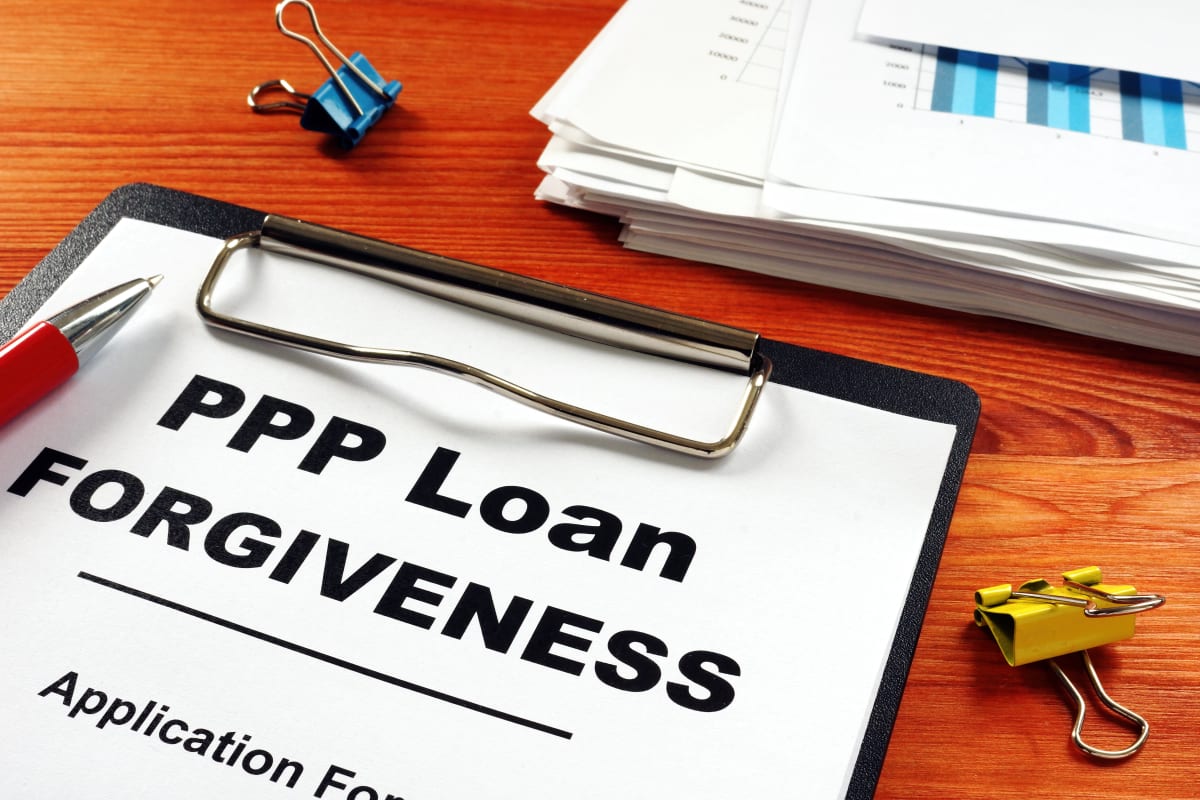If you received a PPP loan for your business during the pandemic, you may still be able to get forgiveness for the loan. We’ll discuss the requirements and steps for applying.
The U.S. Small Business Administration (SBA) has helped many businesses affected by COVID-19 with programs like the Paycheck Protection Program (PPP), COVID-19 Economic Injury Disaster Loan (EIDL), and the Targeted EIDL Advance, but those ended in 2021. However, if your business received a PPP loan, you may still be able to apply for loan forgiveness.
The PPP was intended to help businesses that have been hit hardest by the pandemic keep their workers on the payroll. It was meant to be a forgivable loan, provided certain criteria were met. The forgiveness is not automatic, however; businesses still must apply for it. If you took out a PPP loan and haven’t yet applied for forgiveness, we’ll cover the criteria and the process below.
Understanding the Paycheck Protection Program (PPP)
The Paycheck Protection Program (PPP) was established by the Small Business Administration (SBA) to provide crucial financial assistance to small businesses impacted by the COVID-19 pandemic. This program aimed to help small businesses maintain their workforce and cover essential expenses, such as payroll costs, rent, and utilities.
To qualify for a PPP loan, businesses needed to have fewer than 500 employees and have been in operation on February 15, 2020. The PPP acted as a lifeline for many small businesses, helping ensure they could keep their doors open and their employees paid during challenging times.
Loan Forgiveness Requirements
To have your PPP loan forgiven, the SBA does require you to meet some basic criteria. You may qualify for full loan forgiveness if, during the 8- to 24-week time frame after loan disbursement (when you actually received the funds):
- You maintain employee and compensation levels.
- You spend the loan proceeds on payroll costs and other eligible expenses. For the Second Draw PPP loan in 2021, the definition of “eligible expenses” was broadened to include certain protective equipment, supplier costs, employer-provided group insurance payments, property damage, and operational expenses.
- You spend at least 60% of the proceeds on payroll costs.
Changes for Paycheck Protection Program Loan Forgiveness in 2025
There isn’t currently any proposed legislation that would change the terms of PPP loan forgiveness in 2025. That said, 2025 may be the loan maturity date for many borrowers, which is the deadline to complete a forgiveness application since loans issued after June 5, 2020, have a maturity of five years.
Loan Forgiveness Amounts and Eligibility
The amount of loan forgiveness a borrower can receive is directly tied to how the loan proceeds are used. To be eligible for full loan forgiveness, borrowers must allocate at least 60% of the loan proceeds to payroll costs. The remaining 40% can be used for other eligible expenses, such as rent, utilities, and certain operational costs. Borrowers can apply for loan forgiveness through the SBA’s direct forgiveness portal or by working with their lender. Ensuring that the loan proceeds are used appropriately is key to maximizing the forgiveness amount.
How to Apply
You can apply for PPP loan forgiveness after the full amount of the loan has been spent, any time up to the loan’s maturity date. If you don’t apply for forgiveness within 10 months after the last day of the covered period, your loan payments are no longer deferred, and you’ll start making PPP loan payments to your lender.
Now let’s go over the steps for applying.
Step 1: Use the portal (if you’re eligible)
The SBA has a page dedicated to PPP loan forgiveness, along with the application and instructions. If your PPP loan was $150,000 or less, you can take advantage of the SBA’s Direct Forgiveness Portal, provided you used one of the participating lenders.
The portal allows you to submit the PPP loan forgiveness application directly to the SBA, and the questions are similar to those on SBA Form 3508S.
If you don’t have a participating lender, you’ll have to skip the portal and apply through your lender. They’ll have to provide you with the appropriate form.
Step 2: Get your paperwork together
You’ll likely be required to provide documentation both for payroll and non-payroll expenses you had during the covered period. This will vary by business type, but be prepared to supply the following for payroll:
- Bank account statements or third-party payroll service provider reports that show the amount you paid to your employees.
- Tax forms (or, again, equivalent third-party payroll service provider reports) for the time overlapping with the covered period. This includes payroll tax filings (usually Form 941, the Employer’s Quarterly Federal Tax Return) and state quarterly business and individual employee wage reporting and unemployment insurance tax filings reported, or that will be reported, to the relevant state.
- Any payment receipts, canceled checks, or account statements that document the amount of employer contributions to employee health insurance and retirement plans that the borrower included in the forgiveness amount.
You may be required to have documentation for the following non-payroll expenses during the covered period (though this is not an all-inclusive list). For the first three items, you’ll also have to show documentation that those obligations or services existed before February 15, 2020.
- Business mortgage interest payments: Provide a copy of the lender amortization schedule and receipts verifying payments, or lender account statements.
- Business rent or lease payments: Provide a copy of the current lease agreement and receipts or canceled checks verifying eligible payments.
- Business utility payments: Copies of invoices and receipts, canceled checks, or account statements
- Operations expenditures: Copy of invoices, orders, or purchase orders paid, and receipts, canceled checks, or account statements verifying eligible payments
- Property damage costs: If you’re claiming that some costs were related to uninsured property damage due to vandalism or looting that occurred in 2020, you’ll need copies of invoices, orders, or purchase orders paid, and receipts, canceled checks, or account statements verifying that.
- Supplier costs: Copies of contracts, orders, or purchase orders in effect at any time before the covered period (except for perishable goods), and copies of invoices, orders, or purchase orders paid as well as receipts, canceled checks, or account statements verifying eligible payments
- Worker protection expenditures: Copies of invoices, orders, or purchase orders paid as well as receipts, canceled checks, or account statements verifying eligible payments, and verification that expenditures were used to follow COVID-19 guidance
Step 3: Submit the loan forgiveness application
Once you have your paperwork, it’s time to submit the application. If you met the criteria we mentioned in Step 1, you’ll use the Direct Forgiveness Portal to submit it directly to the SBA. If not, you’ll submit the application and documentation to your lender. Be aware that the lender could request additional documentation to what’s listed here, though.
Step 4: Await the decision (and appeal, if necessary)
Once they receive your application, the SBA or your lender is required to notify you as to their decision within 60 days. If they decide to forgive the loan, bear in mind that it could be for the full amount or only partial. If you didn’t get full loan forgiveness, you’ll be responsible for repaying the remaining amount with 1% interest over the remainder of your loan term. Your lender should let you know when your first payment is due.
Checking the Status of Your Forgiveness Application
Borrowers eager to know the status of their forgiveness application can easily check through the SBA’s direct forgiveness portal or by contacting their lender. The SBA will review the application and determine the amount of forgiveness. For updates, borrowers can reach out to the SBA or their lender directly. Staying informed about the status of your forgiveness application helps ensure that you are aware of any additional steps or documentation that may be required.
Appealing a Denied PPP Loan Forgiveness Application
If the SBA denies your loan forgiveness either fully or partially, you may be able to appeal the decision through the SBA’s Office of Hearings and Appeals (OHA). This is for PPP loan review decisions made by the SBA itself, not decisions made by the lender; you’ll have to contact the lender directly to dispute those.
The SBA has a page with information and filing instructions for PPP appeals. You have 30 days from the date of the decision to make your appeal. Once you do, the deferment period for the loan can be extended until the OHA makes its decision. You’ll need to notify your lender about the appeal so that they can extend the deferment period, allowing you to hold off on making principal or interest payments until a decision is reached.
You’ll need to include the following when submitting your appeal:
- A copy of the SBA loan review decision you’re appealing
- A detailed statement as to why you believe the SBA decision is in error. Include legal arguments and any other pertinent information.
- Your or your attorney’s name, address, phone number, and email address
Once that’s done, watch your email inbox closely, as that’s how the OHA will contact you about how to move forward. They may ask you for additional info/documentation you’ll need to provide. Sometimes they have a tight deadline for supplying this information, so don’t delay. Note that the OHA could also dismiss your appeal if it’s incomplete, deficient, or outside of their jurisdiction.
If you need more help, the SBA has created a call center specifically for PPP loan forgiveness at (877) 552-2692. You can also visit their direct forgiveness knowledge base for answers to frequently asked questions.
Tax Implications of Loan Forgiveness
When it comes to tax implications, forgiven PPP loans generally are not considered taxable income. However, borrowers should be aware that they may need to report the forgiven amount on their tax return. The specific tax implications can vary based on individual circumstances, so it’s highly recommended that borrowers consult with a tax professional to fully understand how loan forgiveness will affect their tax situation. This step is crucial to ensure compliance and avoid any unexpected tax liabilities.
Strengthening Your Business Structure Post-PPP
It makes sense to consider your business structure as you move beyond PPP obligations. While several entity types exist, an LLC provides a balance of liability protection and tax flexibility compared to sole proprietorships, especially when dealing with business finances and obligations. If you’re currently operating as a sole proprietorship, creating an LLC can help protect your personal assets from business liabilities and may offer tax advantages as you position your business for future growth and stability. Starting an LLC is a straightforward process that can significantly improve your business’s legal foundation.”
Resources for PPP Borrowers
The SBA offers a variety of resources to assist PPP borrowers throughout the forgiveness process. These include the direct forgiveness portal, a lender match tool, and a dedicated PPP borrower hotline. Borrowers can also seek assistance from their lender or a local small business development center (SBDC).
The SBA website is a valuable resource, providing detailed information on the PPP program, including eligibility requirements, loan forgiveness, and tax implications. Utilizing these resources can help borrowers navigate the forgiveness process more effectively and ensure they meet all necessary criteria.
Disclaimer: The content on this page is for information purposes only and does not constitute legal, tax, or accounting advice. If you have specific questions about any of these topics, seek the counsel of a licensed professional.


